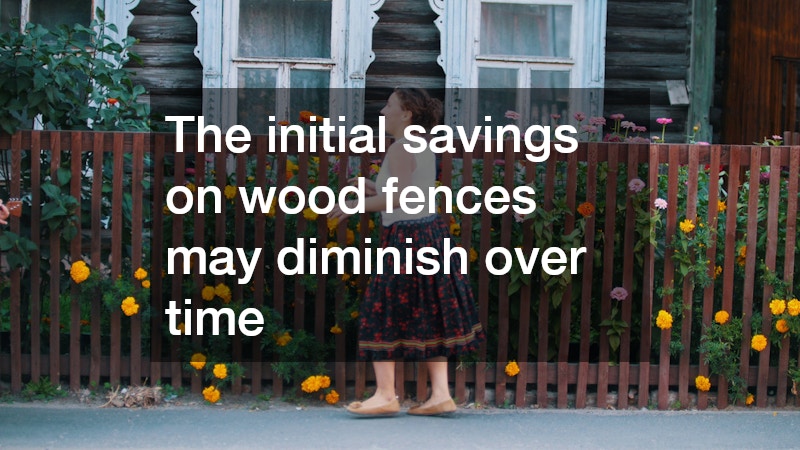When considering fencing options for your property, the debate between wood and vinyl is one that requires careful consideration. Both materials offer their own unique advantages and potential drawbacks. This article aims to uncover the costs associated with each type of fencing, helping you make an informed decision that aligns with your budget and preferences. Consulting multiple fence companies can provide valuable insights into what works best for your property.
Upfront Costs: What You’ll Pay Initially for Wood vs. Vinyl
The initial cost of fencing can significantly influence your choice between wood and vinyl. Wood fences are often less expensive to install than vinyl, with a variety of styles and types available at varying price points.
However, the prices can fluctuate based on the quality of the wood selected, which can affect both appearance and longevity. Fence companies often provide estimates that account for different wood types and installation methods, helping homeowners plan accordingly.
In contrast, vinyl fencing typically has a higher upfront cost due to the manufacturing process and the materials used. This type of fencing is made from durable polyvinyl chloride (PVC), which tends to be more expensive than natural wood. However, this initial expenditure could potentially be offset by reduced maintenance costs in the long run.
It’s important to factor in additional costs that may arise when installing either type of fence, such as labor, permits, and any required fittings. Local regulations or HOA guidelines can also impact your overall expenses. Obtaining multiple quotes from fence companies can provide a clearer picture of the financial commitment you’re making and help ensure competitive pricing.
Maintenance and Longevity: Hidden Expenses Over Time
While wood fences have a lower purchase price, they often require more maintenance over time to prevent issues like rot and warping. Procedures such as staining, sealing, and repairing damaged slats can add up significantly. Homeowners must also consider the lifespan of wood, which varies widely depending on the wood type and climate conditions. Experienced fence companies can advise on the most durable wood options for your local environment.
Vinyl fencing, on the other hand, is known for its durability and low maintenance requirements. It does not splinter, warp, or fade in the same way that wood can. Cleaning is typically as easy as hosing it down, and the material can be expected to last for decades with minimal intervention, making it an attractive option for those wary of ongoing costs.
Assessing the total cost of ownership, including maintenance, can reveal the true financial implications of your choice. The initial savings on wood fences may diminish over time due to continual upkeep, whereas vinyl’s lasting nature might save money in the long run. Discussing long-term maintenance expectations with fence companies can help clarify these potential costs.
Aesthetic and Resale Value: Does Your Choice Pay Off?
The aesthetic appeal of wood versus vinyl fencing can influence property value and curb appeal significantly. Wood offers a natural and traditional appearance that many homeowners and buyers find attractive. It can be stained or painted in various colors to match home exteriors, providing customizable options to suit individual tastes. Many fence companies offer design consultations to ensure your fence complements your home’s style.
Vinyl fencing comes in a diverse range of styles and colors as well, but its uniformity may not appeal to everyone. Some buyers prefer the authentic look of natural materials, which can make wood a more compelling option during real estate transactions. However, well-maintained vinyl fences have a contemporary look that some buyers may favor.
Ultimately, the decision regarding aesthetic preferences can impact resale value. Properties with appealing and appropriate fencing are more likely to draw interest from prospective buyers. High-quality vinyl fencing can provide a modern appeal that some homebuyers actively seek, while a robust wood fence can add charm and character to a property.
Making the Right Choice: Balancing Budget, Style, and Durability
Balancing budget with style and durability is crucial when making a fencing decision. Homeowners must consider their immediate budget constraints against the long-term factors of maintenance and replacement. While wood may appear enticing at first, potential costs of upkeep and repairs should not be overlooked. Consulting multiple fence companies can help you weigh these factors accurately.
Vinyl may have a higher initial cost, but its durability and low maintenance can prove worthwhile over the years. When weighing options, it’s vital to consider how long you intend to stay in your home, as your choice might reflect both investment and personal comfort. Taking the time to explore both materials with guidance from professionals ensures you find the perfect fit for your property.
The decision between wood and vinyl fencing is not merely a matter of initial purchase price; it encompasses a wide range of factors, including maintenance costs, aesthetic preferences, and long-term value implications. By thoroughly examining these aspects and consulting trusted fence companies, homeowners can ensure that their choice aligns closely with both their financial plans and personal style. Understanding the full scope of costs associated with each option will lead to a satisfactory investment in your home.



